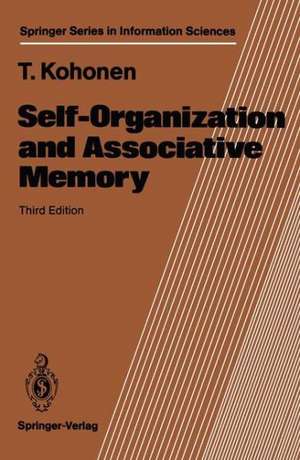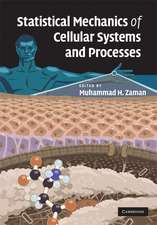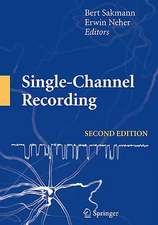Self-Organization and Associative Memory: Springer Series in Information Sciences, cartea 8
Autor Teuvo Kohonenen Limba Engleză Paperback – 14 sep 1989
Din seria Springer Series in Information Sciences
- 20%
 Preț: 337.66 lei
Preț: 337.66 lei - 18%
 Preț: 955.08 lei
Preț: 955.08 lei - 15%
 Preț: 646.62 lei
Preț: 646.62 lei - 20%
 Preț: 337.52 lei
Preț: 337.52 lei -
 Preț: 385.62 lei
Preț: 385.62 lei -
 Preț: 381.98 lei
Preț: 381.98 lei -
 Preț: 391.61 lei
Preț: 391.61 lei - 20%
 Preț: 324.64 lei
Preț: 324.64 lei -
 Preț: 380.84 lei
Preț: 380.84 lei - 18%
 Preț: 777.69 lei
Preț: 777.69 lei -
 Preț: 387.96 lei
Preț: 387.96 lei -
 Preț: 396.62 lei
Preț: 396.62 lei - 20%
 Preț: 330.75 lei
Preț: 330.75 lei -
 Preț: 382.57 lei
Preț: 382.57 lei - 15%
 Preț: 642.18 lei
Preț: 642.18 lei - 15%
 Preț: 640.06 lei
Preț: 640.06 lei -
 Preț: 387.58 lei
Preț: 387.58 lei - 20%
 Preț: 333.40 lei
Preț: 333.40 lei -
 Preț: 386.99 lei
Preț: 386.99 lei - 20%
 Preț: 653.71 lei
Preț: 653.71 lei - 15%
 Preț: 661.02 lei
Preț: 661.02 lei - 18%
 Preț: 1391.21 lei
Preț: 1391.21 lei - 15%
 Preț: 638.43 lei
Preț: 638.43 lei - 15%
 Preț: 642.68 lei
Preț: 642.68 lei -
 Preț: 386.00 lei
Preț: 386.00 lei - 20%
 Preț: 649.60 lei
Preț: 649.60 lei - 18%
 Preț: 950.21 lei
Preț: 950.21 lei -
 Preț: 393.35 lei
Preț: 393.35 lei - 20%
 Preț: 652.41 lei
Preț: 652.41 lei - 20%
 Preț: 645.65 lei
Preț: 645.65 lei -
 Preț: 387.96 lei
Preț: 387.96 lei - 15%
 Preț: 580.97 lei
Preț: 580.97 lei
Preț: 390.25 lei
Nou
Puncte Express: 585
Preț estimativ în valută:
74.67€ • 78.17$ • 61.79£
74.67€ • 78.17$ • 61.79£
Carte tipărită la comandă
Livrare economică 07-21 aprilie
Preluare comenzi: 021 569.72.76
Specificații
ISBN-13: 9783540513872
ISBN-10: 3540513876
Pagini: 332
Ilustrații: XV, 312 p. 100 illus.
Dimensiuni: 155 x 235 x 17 mm
Greutate: 0.47 kg
Ediția:3rd ed.
Editura: Springer Berlin, Heidelberg
Colecția Springer
Seria Springer Series in Information Sciences
Locul publicării:Berlin, Heidelberg, Germany
ISBN-10: 3540513876
Pagini: 332
Ilustrații: XV, 312 p. 100 illus.
Dimensiuni: 155 x 235 x 17 mm
Greutate: 0.47 kg
Ediția:3rd ed.
Editura: Springer Berlin, Heidelberg
Colecția Springer
Seria Springer Series in Information Sciences
Locul publicării:Berlin, Heidelberg, Germany
Public țintă
ResearchCuprins
1. Various Aspects of Memory.- 1.1 On the Purpose and Nature of Biological Memory.- 1.2 Questions Concerning the Fundamental Mechanisms of Memory.- 1.3 Elementary Operations Implemented by Associative Memory.- 1.4 More Abstract Aspects of Memory.- 2. Pattern Mathematics.- 2.1 Mathematical Notations and Methods.- 2.2 Distance Measures for Patterns.- 3. Classical Learning Systems.- 3.1 The Adaptive Linear Element (Adaline).- 3.2 The Perceptron.- 3.3 The Learning Matrix.- 3.4 Physical Realization of Adaptive Weights.- 4. A New Approach to Adaptive Filters.- 4.1 Survey of Some Necessary Functions.- 4.2 On the “Transfer Function” of the Neuron.- 4.3 Models for Basic Adaptive Units.- 4.4 Adaptive Feedback Networks.- 5. Self-Organizing Feature Maps.- 5.1 On the Feature Maps of the Brain.- 5.2 Formation of Localized Responses by Lateral Feedback.- 5.3 Computational Simplification of the Process.- 5.4 Demonstrations of Simple Topology-Preserving Mappings.- 5.5 Tonotopic Map.- 5.6 Formation of Hierarchical Representations.- 5.7 Mathematical Treatment of Self-Organization.- 5.8 Automatic Selection of Feature Dimensions.- 6. Optimal Associative Mappings.- 6.1 Transfer Function of an Associative Network.- 6.2 Autoassociative Recall as an Orthogonal Projection.- 6.3 The Novelty Filter.- 6.4 Autoassociative Encoding.- 6.5 Optimal Associative Mappings.- 6.6 Relationship Between Associative Mapping, Linear Regression, and Linear Estimation.- 6.7 Recursive Computation of the Optimal Associative Mapping.- 6.8 Special Cases.- 7. Pattern Recognition.- 7.1 Discriminant Functions.- 7.2 Statistical Formulation of Pattern Classification.- 7.3 Comparison Methods.- 7.4 The Subspace Methods of Classification.- 7.5 Learning Vector Quantization.- 7.6 Feature Extraction.- 7.7 Clustering.- 7.8Structural Pattern Recognition Methods.- 8. More About Biological Memory.- 8.1 Physiological Foundations of Memory.- 8.2 The Unified Cortical Memory Model.- 8.3 Collateral Reading.- 9. Notes on Neural Computing.- 9.1 First Theoretical Views of Neural Networks.- 9.2 Motives for the Neural Computing Research.- 9.3 What Could the Purpose of the Neural Networks be?.- 9.4 Definitions of Artificial “Neural Computing” and General Notes on Neural Modelling.- 9.5 Are the Biological Neural Functions Localized or Distributed?.- 9.6 Is Nonlinearity Essential to Neural Computing?.- 9.7 Characteristic Differences Between Neural and Digital Computers.- 9.8 “Connectionist Models”.- 9.9 How can the Neural Computers be Programmed?.- 10. Optical Associative Memories.- 10.1 Nonholographic Methods.- 10.2 General Aspects of Holographic Memories.- 10.3 A Simple Principle of Holographic Associative Memory.- 10.4 Addressing in Holographic Memories.- 10.5 Recent Advances of Optical Associative Memories.- Bibliography on Pattern Recognition.- References.














